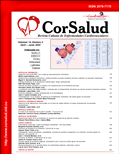BRASH syndrome: A case report
Abstract
BRASH syndrome results as a consequence of a chain of pathophysiological events that generally occurs in elderly patients, with underlying cardiac disease, treated with beta-blockers or calcium channel blockers, and who present hyperkalemia. This combination of events potentiates the adverse effects of these drugs, thus, bradycardia, hypoperfusion and shock may develop. We present the case of a 78-year-old male patient with a history of high blood pressure, diabetes mellitus and stage II chronic kidney disease, who was being treated with carvedilol and who attended the emergency department presenting the clinical features that characterize the syndrome. Despite the implantation of a temporary transvenous pacemaker, he died a few hours later. In this report is highlighted the importance of recognizing the factors that lead to the appearance of this syndrome, and the multimodal treatment that these patients need as part of the therapeutic protocol.
Downloads
References
1. Chacón N, Calderón A, Haro C. Síndrome de BRASH: bradicardia, falla renal, bloqueo auriculoventricular, shock e hiperkalemia. Reporte de un caso. Ciencia Digital [Internet]. 2018 [citado 30 Jun 2021];2(2):567-80. Disponible en: https://doi.org/10.33262/cienciadigital.v2i2.120
2. Farkas JD, Long B, Koyfman A, Menson K. BRASH Syndrome: Bradycardia, Renal Failure, AV Blockade, Shock, and Hyperkalemia. J Emerg Med. 2020;59(2):216-23. DOI: https://doi.org/10.1016/j.jemermed.2020.05.001
3. Srivastava S, Kemnic T, Hildebrandt KR. BRASH syndrome. BMJ Case Rep [Internet]. 2020 [citado 1 Jul 2021];13(2):e233825. Disponible en: https://doi.org/10.1136/bcr-2019-233825
4. Aziz EF, Javed F, Korniyenko A, Pratap B, Cordova JP, Alviar CL, et al. Mild hyperkalemia and low eGFR a tedious recipe for cardiac disaster in the elderly: an unusual reversible cause of syncope and heart block. Heart Int [Internet]. 2011 [citado 1 Jul 2021];6(2):e12. Disponible en: https://doi.org/10.4081/hi.2011.e12
5. Gonuguntla K, Patil S, Manek G, Tandon V, Kaur A. Brash syndrome: lost in plain sight. Chest Journal [Internet]. 2019 [citado 1 Jul 2021];156(4):A2228. Disponible en: http://dx.doi.org/10.1016/j.chest.2019.08.2152
6. Sohal S, Ramachandran A. Syndrome of bradycardia, renal failure, atrioventricular nodal blockers, shock, and hyperkalemia (brash syndrome): a new clinical entity? Chest Journal [Internet]. 2019 [citado 1 Jul 2021];156(4):A74. Disponible en: https://doi.org/10.1016/j.chest.2019.08.168
7. Hanumanthu BKJ, Chugh Y, Grushko M, Faillace RT. Hyperkalemia Presenting as Sinus Bradycardia, Junctional Rhythm and Atrial Bigeminy. Cureus [Internet]. 2019 [citado 2 Jul 2021];11(12):e6439. Disponible en: https://doi.org/10.7759/cureus.6439
8. Arai R, Fukamachi D, Monden M, Akutsu N, Murata N, Okumura Y. Bradycardia Shock Caused by the Combined Use of Carteolol Eye Drops and Verapamil in an Elderly Patient with Atrial Fibrillation and Chronic Kidney Disease. Intern Med [Internet]. 2021 [citado 2 Jul 2021];60(1):79-83. Disponible en: https://doi.org/10.2169/internalmedicine.5598-20
9. Arif AW, Khan MS, Masri A, Mba B, Talha Ayub M, Doukky R. BRASH Syndrome with Hyperkalemia: An Under-Recognized Clinical Condition. Methodist Debakey Cardiovasc J. 2020;16(3):241-4. DOI: https://doi.org/10.14797/mdcj-16-3-241
10. Grados D, Gracia A, Gracia C, Toribio B, León E, Martínez C, et al. Disfunción sinusal transitoria secundaria a tratamiento con lacosamida. CorSalud [Internet]. 2019 [citado 2 Jul 2021];11(2):167-70. Disponible en: http://www.revcorsalud.sld.cu/index.php/cors/article/view/370
11. Carmona R, Lorenzo E. El nodo sinusal normal: Lo que ahora sabemos. CorSalud [Internet]. 2020 [citado 3 Jul 2021];12(4):415-24. Disponible en: http://www.revcorsalud.sld.cu/index.php/cors/article/view/736/1318
12. Long B, Warix JR, Koyfman A. Controversies in Management of Hyperkalemia. J Emerg Med. 2018;55(2):192-205. DOI: https://doi.org/10.1016/j.jemermed.2018.04.004
13. Broz J, Urbanova J, Nunes M, Brabec M, Brunerova L. "Controversies in Management of Hyperkalemia": Remarks on the Risk of Hyperglycemia. J Emerg Med. 2019;56(4):458-9. DOI: https://doi.org/10.1016/j.jemermed.2018.09.057
Downloads
Published
How to Cite
Issue
Section
License
Authors who publish with this journal agree to the following terms:- Authors retain copyright and grant the journal right of first publication with the work simultaneously licensed under a Creative Commons Attribution License that allows others to share the work with an acknowledgement of the work's authorship and initial publication in this journal.
- Authors are able to enter into separate, additional contractual arrangements for the non-exclusive distribution of the journal's published version of the work (e.g., post it to an institutional repository or publish it in a book), with an acknowledgement of its initial publication in this journal.










